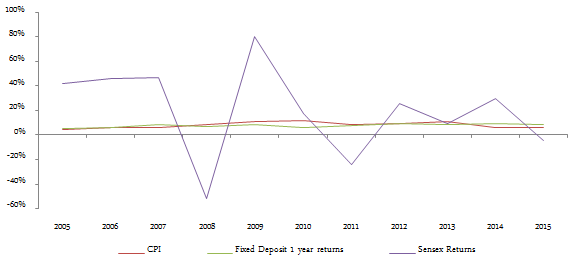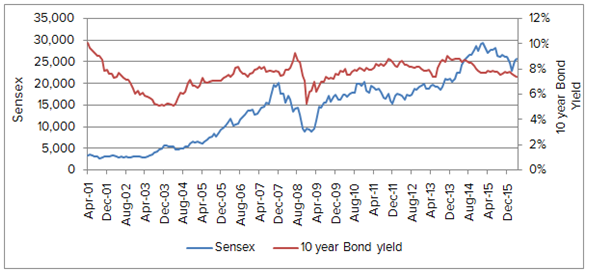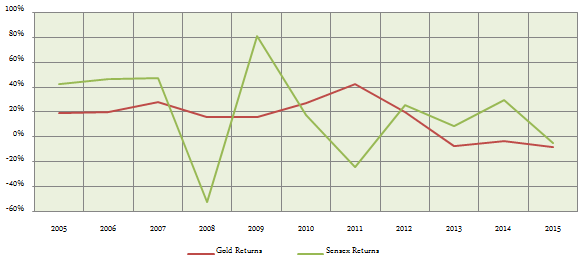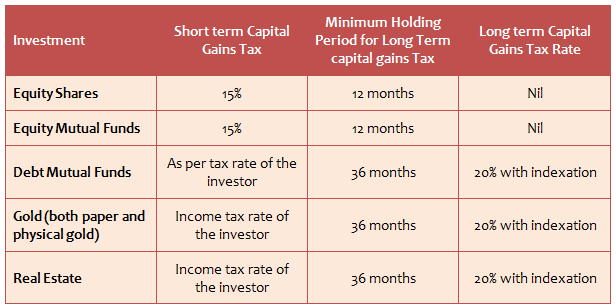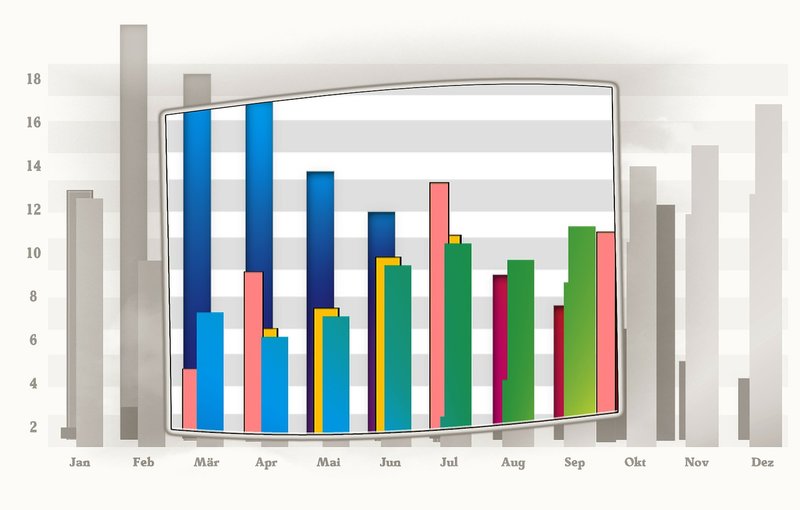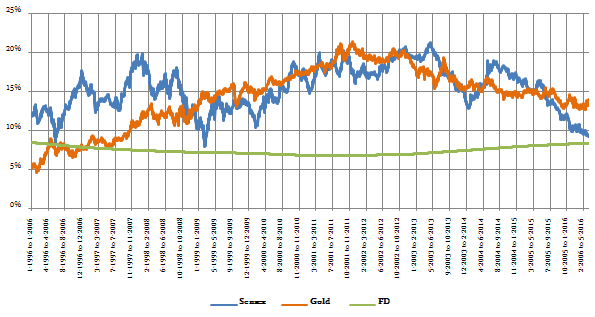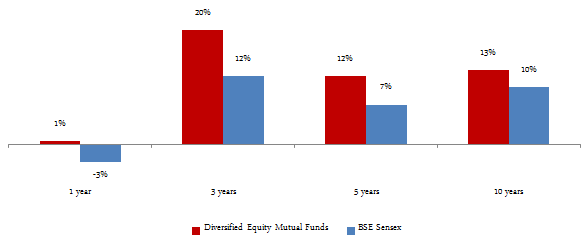by Dwaipayan Bose

We have mentioned a number of times in our blog that, fundamental analysis is the best method to estimate the true or intrinsic value of a stock. Fundamental analysis can help investors determine whether a stock is over-valued, under-valued or fairly valued and help them make long term investment decisions. Fundamental analysts study both macro-economic factors like growth of the overall economy (GDP growth), growth of the industry sector etc and micro-economic factors like the financial condition of the company, market share of the company and quality of the management.
The stock market regulator in India, SEBI, requires all publicly traded companies to submit quarterly and year-to-date standalone financial results to the stock exchange within forty-five days of end of each quarter, along with Limited Review Report or Audit Report as applicable. In addition to quarterly filings, all publicly listed companies are required to submit Annual Audited standalone financial results for the financial year, within sixty days from the end of the financial year along with the audit report. Fund managers and analysts study the quarterly and annual financial results released by the companies to make investment decisions and recommendations.
Fixation with EPS and Net Profit
Financial results submitted by companies as part of their quarterly and annual filings include three important financial statements, Income statement (popularly known as the Profit and Loss account), Balance Sheet and the Cash Flow Statement. You will see that the coverage of quarterly or annual results by the media (television, digital media / internet and print) are primarily focused on the top-line (revenue growth), bottom-line (net profit or PAT growth) and the earnings per share numbers. Out of the three numbers maximum important is usually given to net profit and EPS.
The fixation with net profit is understandable because at the end of the day the investors are interested in share price appreciation. It is believed the EPS growth is the fundamental driver of the share price and EPS is nothing but the net profit divided by the number of shares outstanding. However, expert fund managers believe that, operating cash-flow is the most important metric in reviewing the financial performance of a company.
What is operating cash-flow?
Operating cash-flow is the net cash generated by the business operations. It does not include capital expenditures, investments, acquisitions, sale of assets, funds raised from investors as debt or equity, debt repayment etc.
Why is Operating Cash-Flow more important than Net Profit
Profit or loss is an accounting concept, but ultimately a company requires cash to run its business. A company which generates free cash-flows has a sustainable business. A company which struggles to generate free cash-flows can find it difficult to survive without raising additional capital either as debt or equity, which in the longer run is detrimental to interest of the shareholders of the company.
Income statements may not reveal the true financial health of the company. Income statement has both cash and non cash items. A company can make an accounting profit and still lose cash at the same time. Similarly a company can show a loss in its books, but still have positive cash-flows. A cash-flow statement gives a true picture of a company’s financial condition.
You may sometimes see that, the share price of a company jumping when results are just released and then they come down again after a few minutes. This can happen if investors just look at the reported (net profit or EPS) numbers. Once more financial details are available and investors realize that the EPS was boosted by a one-time item, they will sell the shares and the share price will come down again. Cash-flow statement will tell us if a company is generating profits through normal / sustainable business operations and not through one time activities like sale of assets etc.
Income statements can be subject to accounting manipulations by the management but cash-flows are harder to manipulate under our accounting standards. Hence cash-flows can reveal the true financial picture of the company.
Operating Cash-flow is not EBITDA
I have seen many market commentators and even experts use the terms operating cash-flows and Earnings before Interest, Tax, Depreciation and Amortization (popularly known as EBITDA) interchangeably. It is important for investors to understand that, operating cash-flow and EBITDA are not the same. EBITDA is calculated using the accrual concept in accounting.
Let me explain with the help of an example. Suppose a company manufactures products and sells it to different customers for Rs 1 Crore. The accounting rules allow the company to record Rs 1 Crore as legitimate revenue and will consequently get reflected in the EBITDA. However, in most business to business sales, payment terms allow customers to pay within a certain period (e.g. 30 days) after the receipt of the invoice. Just because the company has recorded revenue of Rs 1 Crore in its books, it does not mean that, it has received Rs 1 Crore in cash. Operating cash-flow, on the other hand, show how much cash was actually received by the company.
How to calculate Operating Cash-Flows?
There are two methods of calculating Operating Cash-Flows. One method uses the Income Statement (P&L account) and Balance Sheet. The other method uses the Cash Flow Statements. Let us discuss the first method using P&L account and Balance Sheet, because these two financial statements are more commonly used by investors.
Find Net Profit from the Income Statement (P&L account)
Add back non-cash items, e.g. depreciation, amortization, deferred taxes etc.
Subtract profit from sales of assets like land, property etc.
Subtract increase in inventory / add decrease in inventory
Subtract increase in accounts receivables / add decrease in accounts receivables
Add increase in accounts payable / subtract decrease in accounts payable
The net result is the operating cash flow.
The method which uses Cash flow statements is the far easier method. I have seen that, many investors ignore the cash-flow statement when reading annual reports. However, expert fundamental analysts and fund managers rely on cash-flow statements to make important investment decisions. A Cash Flow Statement is an account of sources (inflows) and uses (outflows) of cash. From an accounting perspective the cash flow statement is a reconciliation of the Income Statement and Balance Sheet. A cash-flow statement segregates cash-flows into three distinct categories.
Cash Flow from Operating Activities (cash flows from normal business operations)
Cash Flow from Investing Activities (e.g. capex, sale of assets, acquisitions, interest and dividends received etc)
Cash Flow from Financing Activities (e.g. fund raising through debt or equity, debt repayment etc).
The net cash-flow from Operating Activities in the cash-flow statement is the Operating Cash Flow. This is the much simpler method of calculating Operating Cash-Flows.
Conclusion
We are in the middle of the Q1 results / earnings release season. As usual you will see that, most of discussion related to quarterly results on TV or newspapers are centred on earnings (EPS) growth or net profit growth. However, as a smart investor, you should not be led to make investment decisions based on earnings growth alone. You may have heard some investment experts and fund managers talk about the quality of earnings being more important than earnings growth itself. You should use operating cash-flows to get a sense of the quality of earnings and make better investment decisions.
Mutual Fund Investments are subject to market risk, read all scheme related documents carefully.

We have mentioned a number of times in our blog that, fundamental analysis is the best method to estimate the true or intrinsic value of a stock. Fundamental analysis can help investors determine whether a stock is over-valued, under-valued or fairly valued and help them make long term investment decisions. Fundamental analysts study both macro-economic factors like growth of the overall economy (GDP growth), growth of the industry sector etc and micro-economic factors like the financial condition of the company, market share of the company and quality of the management.
The stock market regulator in India, SEBI, requires all publicly traded companies to submit quarterly and year-to-date standalone financial results to the stock exchange within forty-five days of end of each quarter, along with Limited Review Report or Audit Report as applicable. In addition to quarterly filings, all publicly listed companies are required to submit Annual Audited standalone financial results for the financial year, within sixty days from the end of the financial year along with the audit report. Fund managers and analysts study the quarterly and annual financial results released by the companies to make investment decisions and recommendations.
Fixation with EPS and Net Profit
Financial results submitted by companies as part of their quarterly and annual filings include three important financial statements, Income statement (popularly known as the Profit and Loss account), Balance Sheet and the Cash Flow Statement. You will see that the coverage of quarterly or annual results by the media (television, digital media / internet and print) are primarily focused on the top-line (revenue growth), bottom-line (net profit or PAT growth) and the earnings per share numbers. Out of the three numbers maximum important is usually given to net profit and EPS.
The fixation with net profit is understandable because at the end of the day the investors are interested in share price appreciation. It is believed the EPS growth is the fundamental driver of the share price and EPS is nothing but the net profit divided by the number of shares outstanding. However, expert fund managers believe that, operating cash-flow is the most important metric in reviewing the financial performance of a company.
What is operating cash-flow?
Operating cash-flow is the net cash generated by the business operations. It does not include capital expenditures, investments, acquisitions, sale of assets, funds raised from investors as debt or equity, debt repayment etc.
Why is Operating Cash-Flow more important than Net Profit
Profit or loss is an accounting concept, but ultimately a company requires cash to run its business. A company which generates free cash-flows has a sustainable business. A company which struggles to generate free cash-flows can find it difficult to survive without raising additional capital either as debt or equity, which in the longer run is detrimental to interest of the shareholders of the company.
Income statements may not reveal the true financial health of the company. Income statement has both cash and non cash items. A company can make an accounting profit and still lose cash at the same time. Similarly a company can show a loss in its books, but still have positive cash-flows. A cash-flow statement gives a true picture of a company’s financial condition.
You may sometimes see that, the share price of a company jumping when results are just released and then they come down again after a few minutes. This can happen if investors just look at the reported (net profit or EPS) numbers. Once more financial details are available and investors realize that the EPS was boosted by a one-time item, they will sell the shares and the share price will come down again. Cash-flow statement will tell us if a company is generating profits through normal / sustainable business operations and not through one time activities like sale of assets etc.
Income statements can be subject to accounting manipulations by the management but cash-flows are harder to manipulate under our accounting standards. Hence cash-flows can reveal the true financial picture of the company.
Operating Cash-flow is not EBITDA
I have seen many market commentators and even experts use the terms operating cash-flows and Earnings before Interest, Tax, Depreciation and Amortization (popularly known as EBITDA) interchangeably. It is important for investors to understand that, operating cash-flow and EBITDA are not the same. EBITDA is calculated using the accrual concept in accounting.
Let me explain with the help of an example. Suppose a company manufactures products and sells it to different customers for Rs 1 Crore. The accounting rules allow the company to record Rs 1 Crore as legitimate revenue and will consequently get reflected in the EBITDA. However, in most business to business sales, payment terms allow customers to pay within a certain period (e.g. 30 days) after the receipt of the invoice. Just because the company has recorded revenue of Rs 1 Crore in its books, it does not mean that, it has received Rs 1 Crore in cash. Operating cash-flow, on the other hand, show how much cash was actually received by the company.
How to calculate Operating Cash-Flows?
There are two methods of calculating Operating Cash-Flows. One method uses the Income Statement (P&L account) and Balance Sheet. The other method uses the Cash Flow Statements. Let us discuss the first method using P&L account and Balance Sheet, because these two financial statements are more commonly used by investors.
Find Net Profit from the Income Statement (P&L account)
Add back non-cash items, e.g. depreciation, amortization, deferred taxes etc.
Subtract profit from sales of assets like land, property etc.
Subtract increase in inventory / add decrease in inventory
Subtract increase in accounts receivables / add decrease in accounts receivables
Add increase in accounts payable / subtract decrease in accounts payable
The net result is the operating cash flow.
The method which uses Cash flow statements is the far easier method. I have seen that, many investors ignore the cash-flow statement when reading annual reports. However, expert fundamental analysts and fund managers rely on cash-flow statements to make important investment decisions. A Cash Flow Statement is an account of sources (inflows) and uses (outflows) of cash. From an accounting perspective the cash flow statement is a reconciliation of the Income Statement and Balance Sheet. A cash-flow statement segregates cash-flows into three distinct categories.
Cash Flow from Operating Activities (cash flows from normal business operations)
Cash Flow from Investing Activities (e.g. capex, sale of assets, acquisitions, interest and dividends received etc)
Cash Flow from Financing Activities (e.g. fund raising through debt or equity, debt repayment etc).
The net cash-flow from Operating Activities in the cash-flow statement is the Operating Cash Flow. This is the much simpler method of calculating Operating Cash-Flows.
Conclusion
We are in the middle of the Q1 results / earnings release season. As usual you will see that, most of discussion related to quarterly results on TV or newspapers are centred on earnings (EPS) growth or net profit growth. However, as a smart investor, you should not be led to make investment decisions based on earnings growth alone. You may have heard some investment experts and fund managers talk about the quality of earnings being more important than earnings growth itself. You should use operating cash-flows to get a sense of the quality of earnings and make better investment decisions.
Mutual Fund Investments are subject to market risk, read all scheme related documents carefully.


